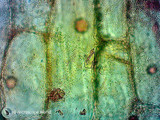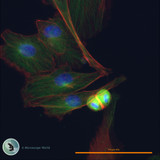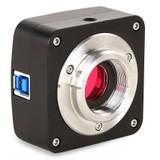Understanding Optical Gels
Jun 19th 2024
What are Optical Gels?
Optical gels are a coupling agent used to match the refractive index of BK-7 glass along with other glass, and fused Silica.
Selecting the Best Optical Gel for the Application
There are different types of optical gels that work better for different uses. Below is a list of applications and the best optical gel for each.
Optical Coupling for Optical Fibers and Optical Compone
…
Understanding BRIX and Brix Liquids
Jun 12th 2024
What is BRIX?
BRIX is a refractive index unit of measurement. Refractive Index is the propensity of light to bend as it passes through liquid. For example, a glass of pure water will bend light that passes through it. As solids are dissolved in water, the light will bend more as the accumulation increases.
What is the BRIX scale used for?
The food industry uses the BRIX scale to measure the estima
…
Refractive Index Liquids
May 20th 2024
What are Refractive Index Liquids?
Refractive index liquids are liquids that have been formulated with a very precise refractive index. A droplet of refractive index liquid is used to identify fragments such as ores, minerals, gems, chemicals, particle fragments, and plastic particles using microscope immersion techniques.
Where are Refractive Index Liquids Used?
Refractive index liquids were orig
…
Discovering Detail with a 1000x Zoom 1080p Microscope Camera
Apr 11th 2024
Does the Microscope Camera Control the Zoom?
Microscope cameras typically don't directly control the zoom of a microscope. Instead, they capture images of what the microscope itself is seeing. The zoom function on a microscope is usually controlled by adjusting the lenses or by changing the magnification settings on the microscope itself. The camera then captures the image at the selected magnific
…
Difference Between Compound & Dissecting Microscopes
Mar 19th 2024
Microscopes play a crucial role in scientific research, allowing scientists to observe objects and organisms at the microscopic level. Two common types of microscopes used in laboratories and educational settings are compound microscopes and dissecting microscopes. While both serve the purpose of magnifying objects for observation, they differ in their design, applications, and functionalities.
Di
…
Simple Microscope
Feb 27th 2024
What Is a Simple Microscope?
A simple microscope is a fundamental optical device comprised of a single lens that magnifies objects when they are placed close to the lens. This lens, typically convex in shape, bends light rays passing through it, allowing for the enlargement of the object's image. Simple microscopes are commonly used for various applications such as reading small text, examining sp
…
Diaphragm Microscope Function
Feb 13th 2024
What Is the Function of the Diaphragm on a Microscope
Among the various components of a microscope, the diaphragm plays a crucial role in controlling the amount of light that passes through the specimen. Essentially, it acts as a gatekeeper for illumination, allowing scientists to adjust the brightness and contrast of their samples for optimal viewing.
The diaphragm, also known as the iris diaphra
…
How To Prepare an Onion Cell Slide
Feb 11th 2024
Peeling Back the Layers of Nature's Microcosm
Microscopy offers a fascinating glimpse into the intricate world of cells, where the seemingly ordinary onion serves as a gateway to understanding cellular structure. In this comprehensive guide, we delve into the process of preparing an onion cell slide, exploring the steps involved and the significance of staining in revealing the hidden details of t
…
How to Use a Microscope Stage Micrometer and Eyepiece Graticule (Reticle)
Feb 8th 2024
Learning how to utilize a microscope effectively involves mastering various accessories and techniques. Among these are the stage micrometer and eyepiece graticule, essential tools for precise measurements and analysis in microscopy. Understanding their functions and proper usage is crucial for obtaining accurate results and maximizing the capabilities of your microscope.
What is a Microscope Stag
…
Mechanical Stage Microscope Function
Feb 6th 2024
What is a Mechanical Stage?
Before diving into its function, let's first understand what a mechanical stage is. In simple terms, a mechanical stage is a platform located beneath the objective lenses of a microscope. It provides a stable and controlled surface for placing and maneuvering specimens under examination. Unlike a simple stage, which relies on manual adjustment of the slide, a mechanical
…
Fluorescence Microscopy
Jan 31st 2024
What Is Fluorescence Microscopy?
Fluorescence microscopy is a type of optical microscopy that uses fluorescence to study the properties of biological and non-biological specimens. In this imaging technique, specimens are labeled with fluorescent dyes or proteins that emit light of a specific color when illuminated with light of a different color. This emitted light is then detected and used to cre
…
Objective Lens vs Ocular Lens
Jan 15th 2024
Objective Lens vs Ocular Lens: What are the Differences?
When it comes to optical instruments like microscopes and telescopes, the objective lens and ocular lens play distinct roles in shaping our viewing experience. Understanding the differences between these crucial components is fundamental to unlocking the full potential of these devices.
The Objective Lens: Unveiling the Power of Magnificatio
…
Viewing Automotive Parts with Polarized Light
Nov 26th 2023
Metallic and reflective surfaces such as automotive parts are best viewed under a stereo microscope with reflected illumination. Using a microscope polarized ring light helps to reduce glare when viewing images under the microscope. The following images were obtained using a stereo microscope with a polarizing ring light.
Below is an image of the edge of an automotive part with no polarization. Th
…
Microscope Cameras - What to Consider When Choosing a Microscope Camera
Nov 20th 2023
Choosing a microscope camera involves considering several factors to ensure it meets your specific needs. Here are key considerations to keep in mind:
Compatibility
Ensure that the microscope camera is compatible with your microscope model. Different microscopes may have varying mounting options and requirements.
Camera Type
Digital vs. Analog: Decide whether you want a digital or analog microscop
…
Van Leeuwenhoek Microscope Rediscovered and Analyzed Using Microscopy
Nov 14th 2023
Antony van Leeuwenhoek, a Dutch man who lived in the Netherlands from 1632 to 1723, is known as the father of microbiology. He created single lens microscopes and wrote a series of detailed letters during his life describing his observations of bacteria and protozoa using his devices, which he called “animacules.” Many of his contemporaries were skeptical of his observations of microsc
…












